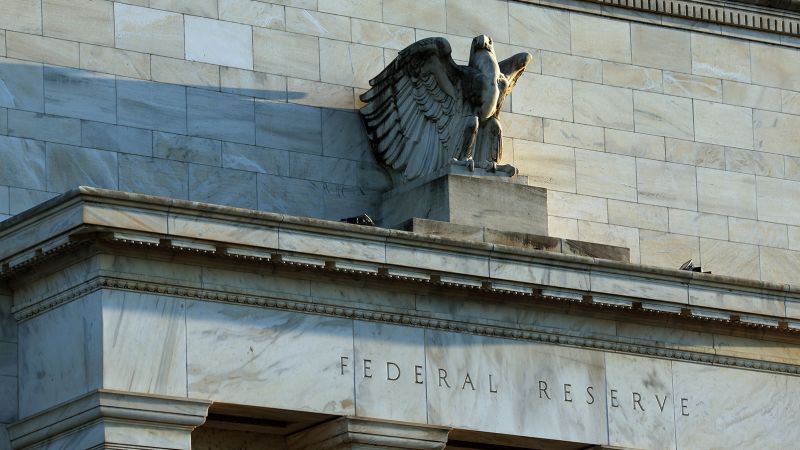A version of this story first appeared in CNN Business’ Before the Bell newsletter. Not a subscriber? You can sign up right here. You can listen to an audio version of the newsletter by clicking the same link.
The Fed’s fight against inflation is about to enter a new phase, but the central bank’s enormous balance sheet will continue to play a key role.
Over the span of about a year and a half, the Fed aggressively raised interest rates to their highest level in 22 years. That’s the Fed’s most famous tool to keep inflation in check and maximize employment — which are its two fundamental functions as mandated by Congress.
But that’s not the only tool available to the central bank as it currently fights inflation. The Fed also manages a multi-trillion-dollar balance sheet that accounts for trillions in government securities and lists how much currency is in circulation.
It is also used as a macroeconomic tool to either weaken or strengthen the economy.
It seems like the Fed might be done raising interest rates — with the possibility of one more hike in December. But the economy is still expanding robustly, the job market remains tight, and inflation continues to be above the 2% target.
That means the Fed has more work to do to cool the economy. The balance sheet has and will continue to help slow the economy as higher-for-longer interest rates do most of the heavy lifting.
Here’s how it works: The Fed holds assets like Treasuries, mortgage-backed securities, and loans extended to banks. It also holds liabilities such as currency, bank reserves and “reserve repurchase agreements,” which are short-term contracts to sell securities then buy them later at a higher price.
Whenever the Fed wants to stimulate the economy, it expands its securities holdings — a strategy known as “quantitative easing.” It did this to help the economy recover from the Great Recession when the Fed dramatically expanded its assets portfolio from less than a trillion in 2007 to more than $2 trillion by 2009.
In the early days of the Covid-19 pandemic, the Fed sharply beefed up its assets portfolio — purchasing a staggering $1.5 trillion in Treasuries in March and April 2020 to stabilize the financial system and cushion the effects of shutdowns on the economy. It continued to gobble up hundreds of billions in government securities throughout 2020
The Fed has been doing the opposite nowadays.
For over a year now, the Fed has been steadily shrinking its balance sheet to help cool the economy. That reduction is known as “quantitative tightening” or a “balance sheet runoff.”
“The balance sheet will play an important role in removing monetary policy accommodation, operating in the background while the federal funds rates serve as our primary active tool,” former Fed Vice Chair Lael Brainard told The Wall Street Journal in 2022 right before the balance sheet runoff and her appointment as vice chair.
The Fed’s balance sheet is currently at around $7.9 trillion, down from its peak of $9 trillion in early 2022 right before the runoff.
What’s next: Wells Fargo economists expect a recession sometime next year to prompt the Fed to cease quantitative tightening around October 2024, leaving the balance sheet at around $7.2 trillion.
“In our view, the [Fed] is unlikely to continue passive monetary policy tightening via [quantitative tightening] during a period of negative GDP growth, rising unemployment and material cuts to the federal funds rate,” they wrote in a recent analysis.
They also see alternative scenarios for the end of the balance sheet runoff if there isn’t a recession.
Fed Chair Jerome Powell said in a news conference following the central bank’s July policy decision that quantitative tightening could continue even during rate cuts. Wells Fargo economists say that “would allow the FOMC to attempt to return the balance sheet to roughly its ‘equilibrium’ size.”
How rate hikes work: The Fed decides to either raise, lower or keep unchanged its key federal funds rate at each of its eight scheduled Federal Open Market Committee meetings every year, influencing short-term interest rates across the economy.
Whenever inflation surges, the Fed responds by lifting the fed funds rate, prompting interest rates on a wide range of loan products to follow suit. Those higher lending costs should in turn cool the economy enough to slow price increases, thus stabilizing inflation.
However, whenever a weakening economy pushes unemployment higher, the Fed responds by lowering the fed funds rate, making lending cheaper and shoring up economic growth.
Sometimes the Fed leaves interest rates unchanged if officials need more data on the health of the economy or if they think growth is trending in the right direction.
Manipulating the fed funds rate — which is the interest rate commercial banks charge each other when lending excess bank reserves — is the Fed’s most well-known method of making an impact on the economy, since it has a strong effect on the accessibility of credit.
JPMorgan Chase’s Jamie Dimon and his family to sell $141 million of stock in 2024
JPMorgan Chase chief executive Jamie Dimon and his family plan to sell one million of their shares in the bank starting next year, according to a new securities filing, my colleague Krystal Hur reports.
Dimon — who will use his stock trading plans to offload his shares — and his family currently own roughly 8.6 million shares in the company. The move marks Dimon’s first stock sale during his 17 years at the company’s helm.
JPMorgan Chase shares closed at $140.76 on Thursday, putting the transaction’s worth at roughly $141 million.
“Mr. Dimon continues to believe the company’s prospects are very strong and his stake in the company will remain very significant,” JPMorgan Chase said in the filing.
CNN has reached out to the company for comment.
Shares of JPMorgan Chase have climbed roughly 5% this year during what’s been a tough environment for banks. The Federal Reserve’s aggressive pace of interest rate hikes, which began in 2022, has crimped demand for loans and forced banks to pay up for clients’ high-yielding holdings. At the same time, banks have watched the value of their own bond investments erode in value.
Read the full story here.
Monday: Earnings from HSBC, McDonald’s, Public Storage, and Pinterest. China’s National Bureau of Statistics releases October surveys gauging economic activity in the country’s manufacturing sector. The Bank of Japan announces its latest monetary policy decision.
Tuesday: Earnings from Pfizer, Caterpillar, Marathon Petroleum, Sirius XM, Anheuser-Busch, BP, Stellantis, Sysco, Match Group, and Chesapeake Energy. The European Union’s statistics agency releases third-quarter gross domestic product and October inflation figures. The US Labor Department releases its Employment Cost Index for the third quarter. S&P Global releases its S&P CoreLogic Case-Shiller 20-city home price index for August. The Conference Board releases its Consumer Confidence Index for October.
Wednesday: Earnings from CVS, GSK, Humana, Reuters, Estee Lauder, Apollo Global Management, Kraft Heinz, Yum! Brands, Garmin, Norwegian Cruise Line Holdings, Bausch + Lomb, Wingstop, Sunoco, Wayfair, Mondelez, Qualcomm, Airbnb, PayPal, MetLife, Aflac, AIG, Allstate, Prudential, DoorDash, Marathon Oil, Zillow, Roku, Etsy, Avis, and Elf. The US Labor Department releases September figures on job openings, quits, hire and layoffs. S&P Global and the Institute for Supply Management release October surveys gauging economic activity in the US manufacturing sector. The Federal Reserve announces its latest monetary policy decision.
Thursday: Earnings from Eli Lilly, Shell, ConocoPhillips, S&P Global, Starbucks, Cigna, Duke Energy, Shopify, Ferrari, Marriott International, Palantir, Moderna, Fox, Molson Coors, Hyatt, Apple, Motorola, DraftKings, LiveNation, Expedia, GoDaddy, and Dropbox. The Bank of England announces its latest monetary policy decision. The US Labor Department reports the number of worker filings for unemployment benefits in the week ended October 28 along with third-quarter data on nonfarm productivity.
Friday: Earnings from Dominion Energy, Gartner, and Restaurant Brands International. S&P Global and the Institute for Supply Management release October surveys gauging economic activity in the US services sector. The US Labor Department reports on the state of the job market in October, including monthly payroll growth, wage gains and the unemployment rate.
Read the full article here







